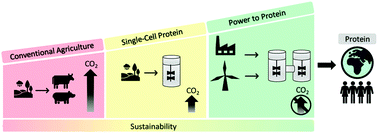当前位置:
X-MOL 学术
›
Energy Environ. Sci.
›
论文详情
Our official English website, www.x-mol.net, welcomes your
feedback! (Note: you will need to create a separate account there.)
Power-to-protein: converting renewable electric power and carbon dioxide into single cell protein with a two-stage bioprocess†
Energy & Environmental Science ( IF 32.4 ) Pub Date : 2019-08-12 , DOI: 10.1039/c9ee02381j Bastian Molitor 1, 2, 3, 4 , Akanksha Mishra 1, 2, 3, 4 , Largus T. Angenent 1, 2, 3, 4
Energy & Environmental Science ( IF 32.4 ) Pub Date : 2019-08-12 , DOI: 10.1039/c9ee02381j Bastian Molitor 1, 2, 3, 4 , Akanksha Mishra 1, 2, 3, 4 , Largus T. Angenent 1, 2, 3, 4
Affiliation

|
To prevent an environmental collapse while feeding a future human population of 10 billion people, dilute nitrogen in waste streams as a nitrogen source and carbon dioxide as a carbon source should be recovered and recycled into edible protein as part of the circular economy. For this to work, however, ample renewable electric power would be necessary to provide hydrogen from water electrolysis as an electron donor. We developed a two-stage bioprocessing system as part of a power-to-protein approach to fix carbon dioxide in a first stage by anaerobic acetogenic bacteria, and grow yeasts or fungi in a second stage under aerobic conditions with acetate as the intermediate metabolite. We were able to obtain a carbon yield of 25% as yeast biomass with a protein mass-fraction of ∼40–50% during a proof-of-concept experiment. We developed a technological solution to circumvent conventional agriculture for protein production, while still being able to provide protein for human consumption.
中文翻译:

蛋白质发电:通过两步生物过程将可再生电力和二氧化碳转化为单细胞蛋白质†
为防止环境恶化,同时养活未来的100亿人口,应回收废物流中的稀氮作为氮源,将二氧化碳作为碳源,并作为循环经济的一部分循环利用为可食用的蛋白质。然而,为了使它起作用,将需要足够的可再生电力来从水电解中提供氢作为电子供体。我们开发了一个两阶段的生物处理系统,作为动力转化为蛋白质的方法的一部分,以在第一阶段通过厌氧产乙酸细菌固定二氧化碳,并在第二阶段在有氧条件下以醋酸盐作为中间代谢产物培养酵母或真菌。在概念验证实验中,作为酵母生物量,我们能够获得25%的碳产率,蛋白质质量分数约为40–50%。
更新日期:2019-12-04
中文翻译:

蛋白质发电:通过两步生物过程将可再生电力和二氧化碳转化为单细胞蛋白质†
为防止环境恶化,同时养活未来的100亿人口,应回收废物流中的稀氮作为氮源,将二氧化碳作为碳源,并作为循环经济的一部分循环利用为可食用的蛋白质。然而,为了使它起作用,将需要足够的可再生电力来从水电解中提供氢作为电子供体。我们开发了一个两阶段的生物处理系统,作为动力转化为蛋白质的方法的一部分,以在第一阶段通过厌氧产乙酸细菌固定二氧化碳,并在第二阶段在有氧条件下以醋酸盐作为中间代谢产物培养酵母或真菌。在概念验证实验中,作为酵母生物量,我们能够获得25%的碳产率,蛋白质质量分数约为40–50%。











































 京公网安备 11010802027423号
京公网安备 11010802027423号